(This is a continuation of my earlier post. Note: I’ve included links to Amazon. If you use the links and subsequently buy shit from Amazon… no matter what it is… I get a tiny kickback. I will use it to buy whiskey and fishing lures! The kickback costs you nothing. Amazon requires me to inform you of this. I suppose they want to protect the last living being on earth who has no idea how affiliate links work. Also, if you think I’ve got a nefarious plan to manipulate my millions and millions of deeply devoted and incredibly rich readers so that I can amass funds to buy a yacht a nickel at a time, this is the proof.)
I’ve got cabin fever. I couldn’t wait for proper weather so I did a test in shitty weather, which I suppose is a much better test. In mid-test the shitty weather got immeasurably worse; because of course it did. At least I got a good cup of coffee out of it.
The first photo is the first firing of my Coleman 533 Dual Fuel stove. I don’t know how many of these are still out there but if you’re interested in getting your own, don’t dawdle!
You know it’s brand new because there’s no soot on the top. It’s scandalously clean. In this photo it isn’t even heated up yet, that’s why the flame is yellow.
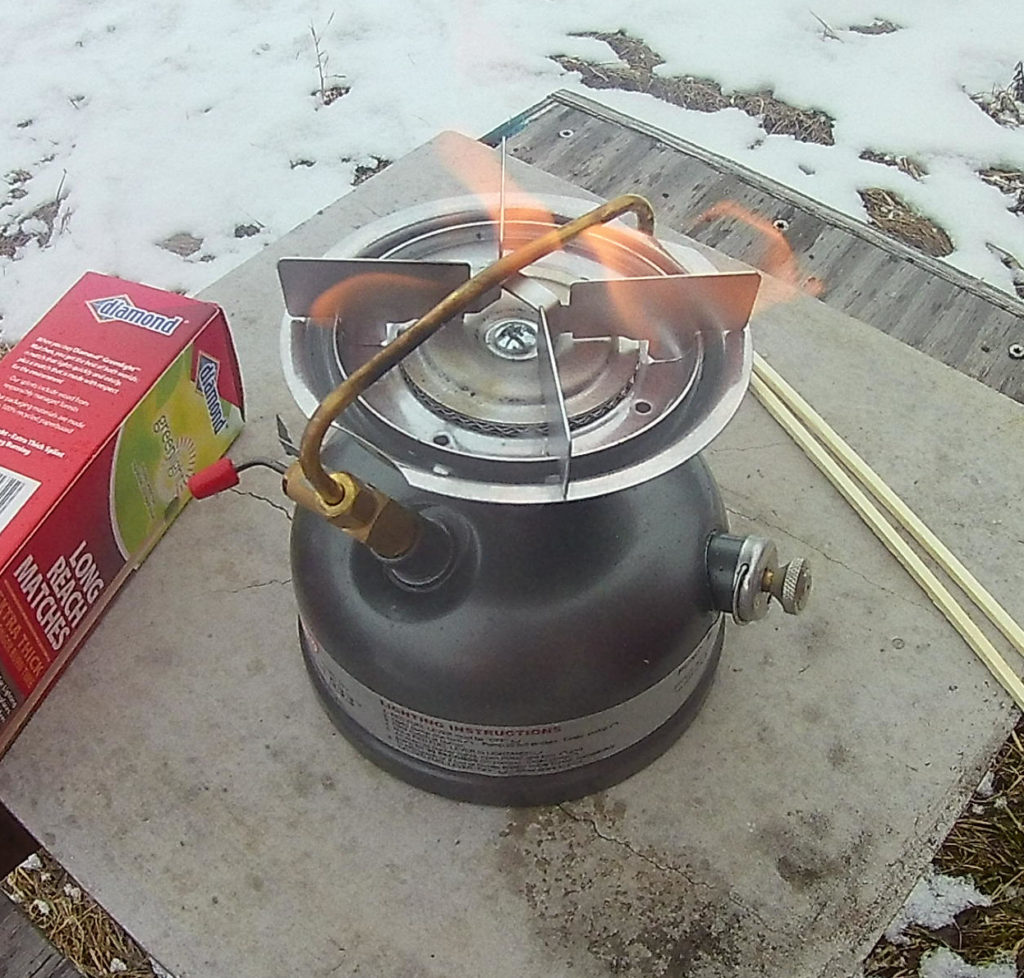
A word about fuel:
For fuel I was burning “Crown brand” white gas from Walmart. I didn’t treat this fuel particular well. I got it last year for a failed test of my two old white gas devices. That means I broke the seal and used some of the can. Then left the rest of the can in a freezing garage over the winter. It seems OK.
Don’t get screwed when buying fuel. Coleman sells its brand of white gas for $11.99 a quart. That doesn’t sound too bad until you do the math and come up with a heart attack inducing $48 a gallon! Holy crap!
Walmart sells Crown brand white gas for $7.64 a gallon (or at least that’s what their web page says, I can’t remember what I paid last year). I can’t imagine there’s any difference between the two brands.
Camp stoves don’t need a lot of fuel but it adds up. Compare $48 for a gallon of Coleman brand, $7.64 for a gallon of Crown brand, versus $5 a gallon for unleaded (which the dual fuel stove can digest). Those are big differences!
(Let pause now to reflect on fuel prices and our super smart and very active president who undeniably, unquestionably, without the slightest doubt, won the highest number of votes ever recorded in America. Gasoline prices doubling during his first 15 months in office is unquestionably someone else’s fault and that’s why he’s just so darned popular.)
The stove’s packaging says that 1 gallon of white gas is the equivalent of 4.5 pounds of propane. That seems to agree with what I’ve read on-line. I’m a little sketchy on the current cost of a one pound disposable propane tanks or most anything else that I can’t personally verify. A while ago I stocked up on disposable 1 pound tanks for $4 a pop but that was before the unassailable, squeaky clean, election that had the highest vote count ever tallied. For reasons utterly unrelated to that event, I don’t think anyone will be buying propane canisters for $4 in the foreseeable future. Right now Amazon is selling camping propane at $10 each. I can’t believe $10 is the normal cost?!? That’s nuts right? For the sake of discussion, I’m going to assume $6 per one-pound tank is the reasonable price nowadays? That means $27 worth of disposable propane tanks (adjusting for one that will be only half consumed and paying $6 each) to equal $5 in unleaded or $8 of white gas bought at Walmart.
I haven’t tested with unleaded yet. It is said that white gas burns cleaner than the EPA mandated witches brew they sell at an unleaded pump. I don’t doubt it. Some folks get all whiny that using unleaded will clog up the stove and do all sorts of mayhem. This seems more “perceived wisdom” than people who’ve tried it. Others say they’ve personally used unleaded for many years and report it’s fine. Once I get the ball rolling, I intend to use unleaded exclusively. If it’s a bad idea I’ll let you know. (I’ll be prepared for more frequent cleanings.) By my math, even if unleaded nukes a generator after a few years, the replacement generator will cost vastly less than the consumption of more expensive fuel.
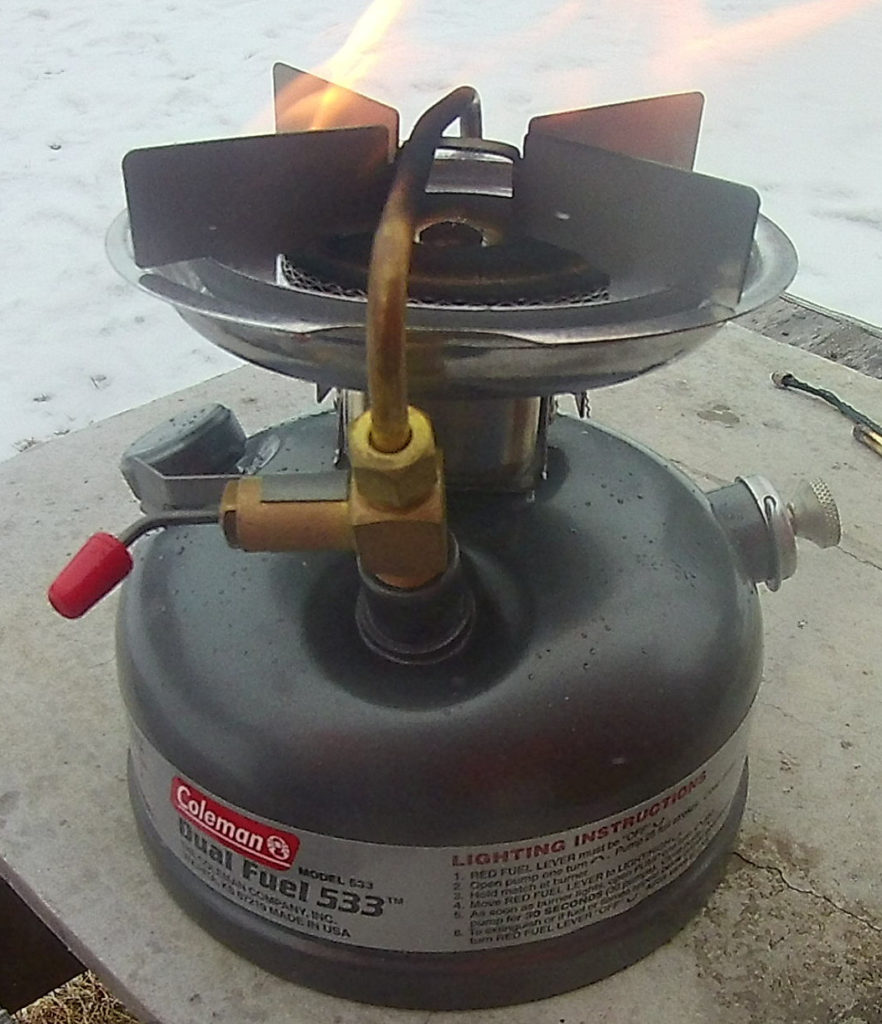
You can see the difference between the above photo which is not too far from operating temp and brand new below. BTW: The soot on the burner is not a problem It’s supposed to get discolored.
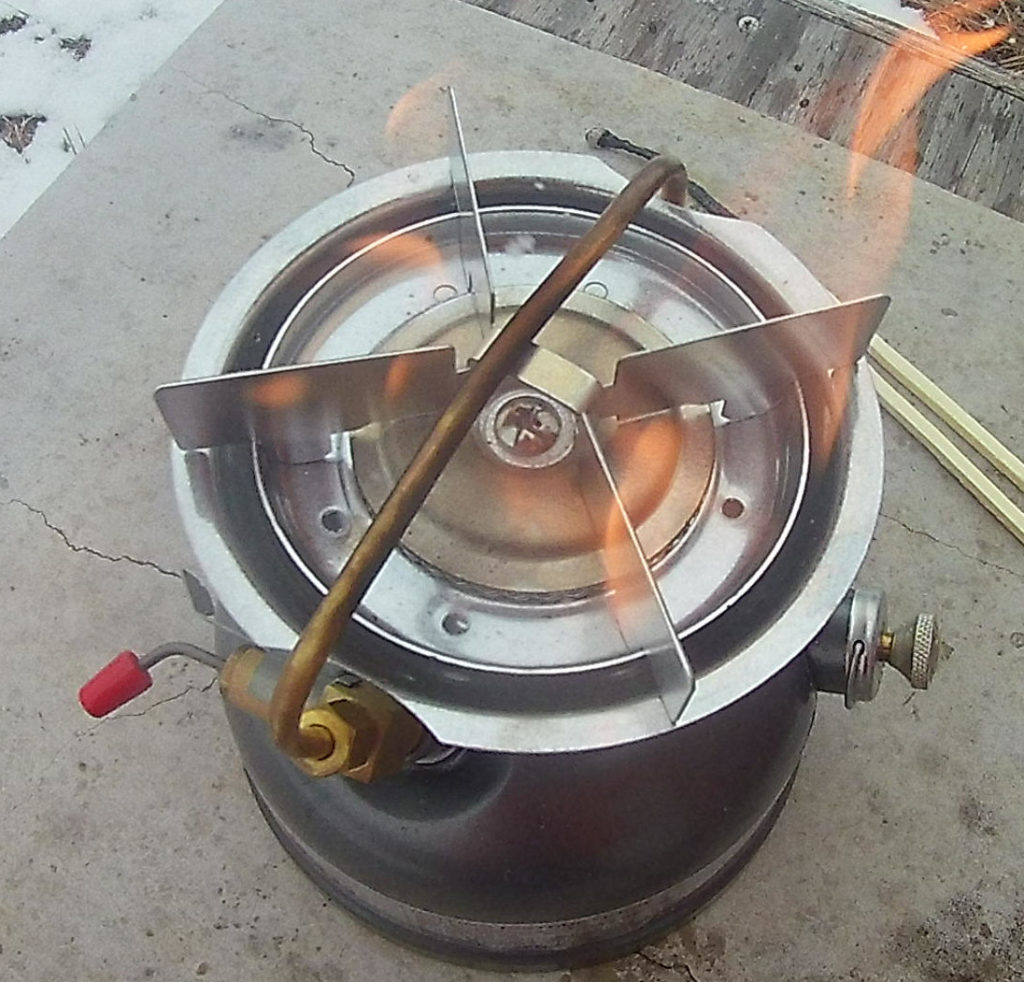
A propane burner’s flame is nice and blue within seconds. A liquid fuel burner takes a minute or two to warm up. The snow started blowing and that didn’t make me feel very patient. (You can see snow melting on the tank.)
Now for the test. COFFEE!
A word about percolators:
This test involved a new Stanley Percolator. Mrs. Curmudgeon heard me whining about my other camp percolator and got me this one for Christmas. She’s a keeper!
There’s a reason why I’m particular about percolators… actually there’s two. The first is that I take coffee seriously. The second is that my previous percolator was more optimized for an open fire than a stove. It is big and clunky and sooty. Also too much of a hassle for inside my hot tent. (I’ve already tested the new percolator on a wood stove inside a tent.)
On a stove there’s no smoke to mess up the shiny percolator. I’ve also tested it on a propane burner and there was no soot from that either. (Much like a house with a kitchen LP stove doesn’t soot up a frying pan.)

I have had other percolators. A pretty blue one Mrs. Curmudgeon got me sprung a leak after a few year’s use. That’s weird, but it happened. Shame because it was cool. Here’s the old blue on a generic propane burner. Pretty, but on the propane stove it was tall and wobbly!

Later I bought a stainless steel percolator. I’ve used the hell out of it. Here it is when brand new (also perched on a propane burner):
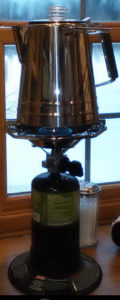
Here’s a photo of that same percolator on a campout last year. I wash the shit out of that percolator after every trip but as you can see, it gets pretty sooted up when I’m burning wood (in this case pallet wood). The big wide bottom is ideal for a fire or my folding outdoor woodstove. (Also, the lid is a little warped but it has been used hard so I can’t complain.)

The new percolator is totally unblemished but it is camping gear. It must be tested as it will be used. It was born soot free but it will not stay that way!
Here’s an important note. The Stanley percolator fits on a propane campstove but not well… it’s a little too narrow and it feels sketchy. I checked the Stanley’s fit on an MSR burner and it was the same; adequate but not great. (In case you’re wondering, I walked into a sporting goods store carrying a percolator and put it on the display model MSR to see the fit.)
To my delight the Stanley percolator fits more or less perfectly on the Coleman stove!
Here’s the virgin percolator and the brand new stove:
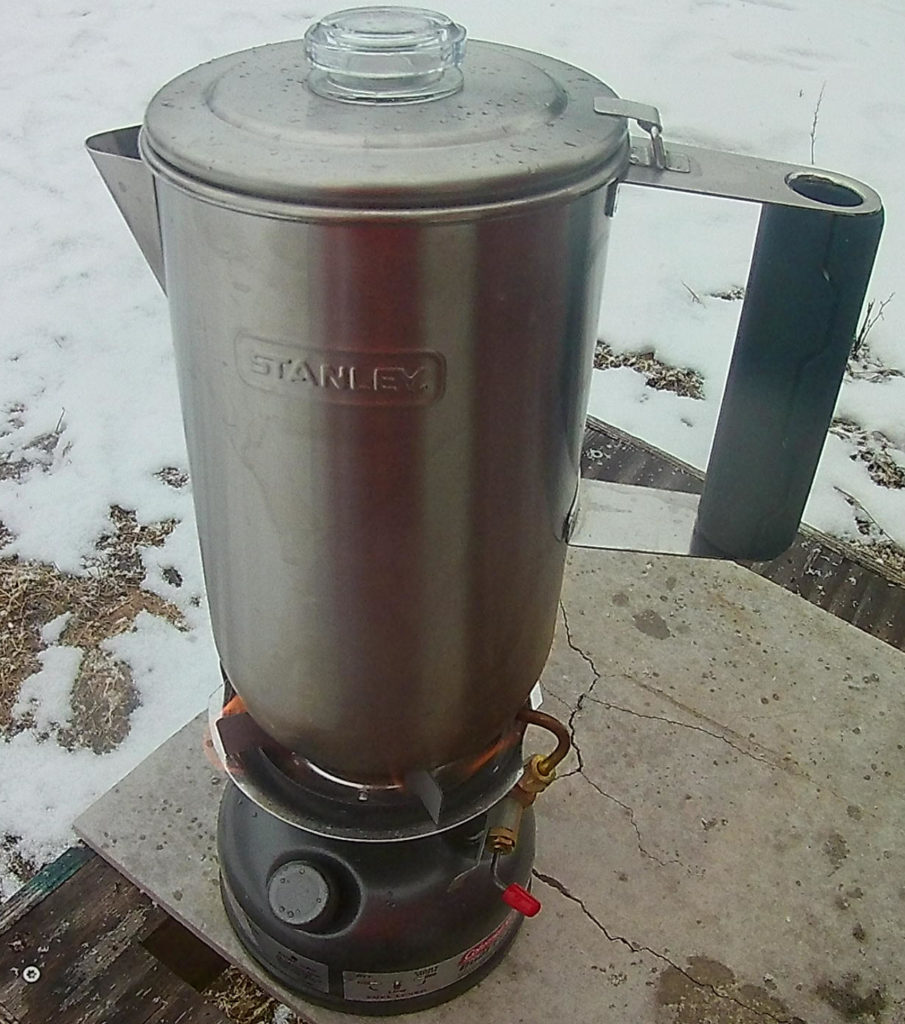
When camp cooking, I rub bar soap on the bottom of anything that’s going to get sooty. I do this before I cook. That way cleanup is much easier. I didn’t know if that was necessary over white gas so I didn’t do it. That was probably the correct call. There’s more soot than from propane but vastly less compared to wood. BTW: I’ve sent the percolator through the dishwasher a half dozen times already. It works great. It’s a tool not a display piece.
There’s a silicone handle cover that’s removable. The instructions say to remove the silicone piece if handle is exposed to flame. On the propane burner I think I’ve left it on but I can’t remember. On the tent’s wood stove I left it on because there was heat but no flame. On the Coleman 533 I removed it because the flames occasionally went up and around the percolator’s base.
I’m not sure how tough that handle is but I don’t want to damage it. Also, I’m extra careful that I don’t lose the handle. I’m sure Stanley would rake me over the coals for a replacement if it was even possible to source one. Here’s a picture with the silicone piece removed. I can almost smell the coffee!

It came together perfectly. The percolator is now “broken in”.
I tried to block the wind but it was a pretty lame attempt that wasn’t very successful. I guess I’ve proven that I can percolate coffee in 20 degree weather with wind blowing the flame all over the place and snow landing on everything. I don’t know how much that affects cook time but it can’t help. It wasn’t as fast as I’ve gotten used to from summertime use.
Incidentally, the coffee was excellent. I mean just plain incredible!
Successful test, but immediately after the coffee was ready it was over. I was driven back indoors by the elements. We now have an additional 3″ of snow on the ground.

As a Neanderthal I refill my 1# propane bottles. You’ll never be able to refill them completely (at least not safely) you usually get them 75-80% full. Refilling my one of my 20# tanks last month was a bit under $17 and that equates to 16-17 pounds of propane. Unless you have a tank that can’t be refilled (bad threads or out of date inspection) never ever exchange tanks at a gas station or store. Those places commonly only fill the tanks with 12-14 pounds of propane.
At that rate (17/20 = $0.85) it would cost $3.83 in propane to get the equivalent of 1 gallon of white gas. Aside from twig stoves that’s the first time someone’s had fuel costs cheaper than unleaded. (I don’t know current prices, is $3.83 still less than the cost of a gallon of gasoline?)
I just exchanged a tank for $22. Now I’m pissed that I was ripped off!
When I have a 1 pound tank that’s no good to refill (I’ve had a few get rusty and one was dented) I “de mill” them with a rifle shot. I’ve never had one catch flame but it’s still fun to watch the remaining gas vent suddenly… from a safe distance of course. I reason that it’s not safe to be tossing a sketchy not entirely empty pressure vessel in the waste stream, but mostly it’s just fun to shoot them.
Buy your gas generator replacements(and other parts) NOW.
They won’t go bad sitting on the shelf and they will be discontinued very soon.
I’ll probably do just that.